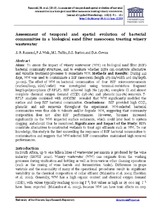| dc.contributor.author | Ramond, Jean-Baptiste | |
| dc.contributor.author | Welz, P.J. | |
| dc.contributor.author | Tuffin, Marla | |
| dc.contributor.author | Burton, Stephanie G. | |
| dc.date.accessioned | 2018-02-07T09:54:48Z | |
| dc.date.available | 2018-02-07T09:54:48Z | |
| dc.date.issued | 2013 | |
| dc.identifier.citation | Ramond, J-B. et al. (2013). Assessment of temporal and spatial evolution of bacterial communities in a biological sand filter mesocosm treating winery wastewater. Journal of Applied Microbiology, 115(1): 91 – 101 | en_US |
| dc.identifier.issn | 1364-5072 | |
| dc.identifier.uri | http://dx.doi.org/10.1111/jam.12203 | |
| dc.identifier.uri | http://hdl.handle.net/10566/3484 | |
| dc.description.abstract | AIMS: To assess the impact of winery wastewater (WW) on biological sand filter (BSF) bacterial community structures, and to evaluate whether BSFs can constitute alternative and valuable treatment-processes to remediate WW. METHODS AND RESULTS: During 112 days, WW was used to contaminate a BSF mesocosm (length 173 cm/width 106 cm/depth 30 cm). The effect of WW on bacterial communities of four BSF microenvironments (surface/deep, inlet/ outlet) was investigated using terminal-restriction fragment length polymorphism (T-RFLP). BSF achieved high Na (95·1%), complete Cl and almost complete chemical oxygen demand (COD) (98·0%) and phenolic (99·2%) removals. T-RFLP analysis combined with ANOSIM revealed that WW significantly modified the surface and deep BSF bacterial communities. CONCLUSIONS: BSF provided high COD, phenolic and salt removals throughout the experiment. WW-selected bacterial communities were thus able to tolerate and/or degrade WW, suggesting that community composition does not alter BSF performances. However, biomass increased significantly in the WW- impacted surface sediments, which could later lead to system clogging and should thus be monitored. SIGNIFICANCE AND IMPACT OF THE STUDY: BSFs constitute alternatives to constructed wetlands to treat agri effluents such as WW. To our knowledge, this study is the first unravelling the responses of BSF bacterial communities to contamination and suggests that WW-selected BSF communities maintained high removal performances. | en_US |
| dc.language.iso | en | en_US |
| dc.publisher | The Society for Applied Microbiology | en_US |
| dc.rights | This is the author-version of the article published online at: http://dx.doi.org/10.1111/jam.12203 | |
| dc.subject | Bioaugmentation | en_US |
| dc.subject | Biological sand filters | en_US |
| dc.subject | Constructed wetland | en_US |
| dc.subject | Remediation | en_US |
| dc.subject | T-RFLP analyses | en_US |
| dc.subject | Wastewater treatment | en_US |
| dc.title | Assessment of temporal and spatial evolution of bacterial communities in a biological sand filter mesocosm treating winery wastewater | en_US |
| dc.type | Article | en_US |
| dc.privacy.showsubmitter | FALSE | |
| dc.status.ispeerreviewed | TRUE | |
| dc.description.accreditation | Web of Science | |

